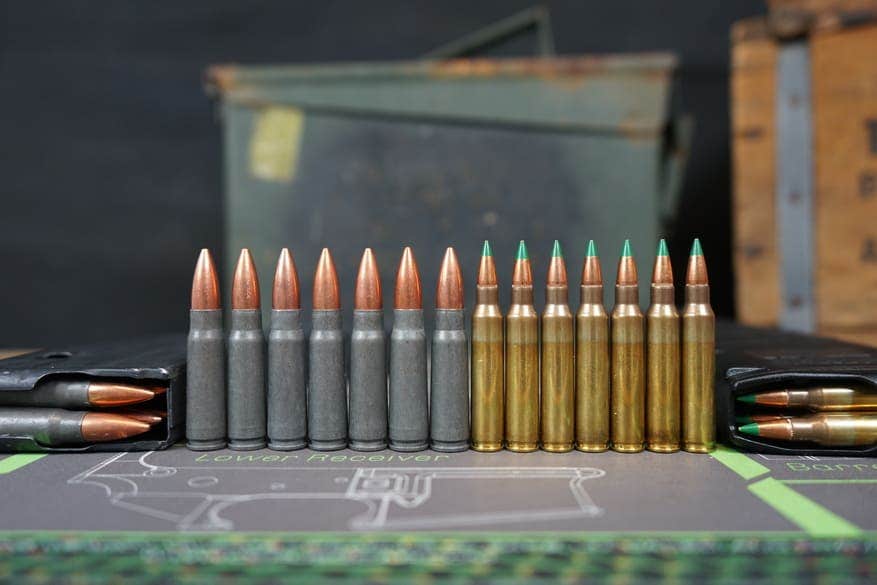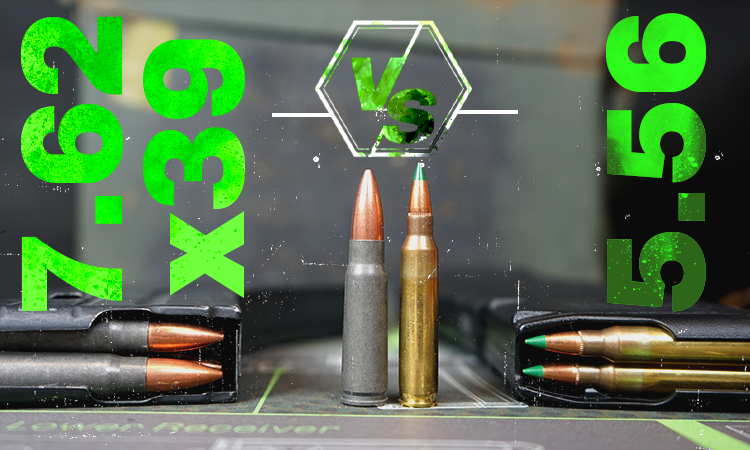If you’re ready to enter the world of intermediate cartridges, there are really two 800-lb gorillas that you should consider -- the .223 Remington/5.56 NATO and 7.62x39 Soviet.
There is a lot of overlap between the two, but there are also some major differences. I’ll break them all down and give you some helpful guidelines to get you started!
But first, some history!
Histories

.223 Remington / 5.56 NATO
Designed by a lot of people working together from Remington, Winchester, DuPont, ArmaLite, and Fairchild Industries. Eugene Stoner also played a major role in the development process since it was being done side-by-side with his work to down-size the AR-10 into the AR-15 design.
All of this would eventually result in the .223 Remington.
What started it all? A request from U.S. Continental Army Command in 1957 for a small-caliber, high-velocity cartridge to replace the .308 Winchester.
Using a 55-grain bullet and looking to achieve a muzzle velocity of about 3,300 feet-per-second testing and development started by using the .222 Remington and a 22” barrel.
However, chamber pressures were deemed too high. Stoner asked Winchester and Remington to expand the case slightly to reduce pressure but maintain velocity. The modified version was called .222 Special.
After more testing, including a head-to-head test with the T44E4 (what would become the M-14) using .308, the .222 Special was considered outstanding and approved for adoption.
Since there were other .222 cartridges and projects in the works, it was decided to rename the cartridge to .223 Remington.
And the kicker? This whole time, the caliber of the bullets being used was actually .224.

7.62x39 Soviet
In July of 1943 the Technical Council of the People's Commissariat for Armaments (Техсовет Наркомата Вооружения) met to discuss the development and adoption of a new intermediate cartridge.
They decided that this cartridge should be mild-recoil and was to be used in a wide range of guns including a semi-automatic carbine, select fire rifle, and in full-auto LMGs.
Development was assigned to chief designer N.M. Elizarov (Н.М. Елизаров) who set to work on the project. He consulted other major soviet firearm designers such as Fedorov and Tokarev but the bulk of production was completed by him and his team.
In December of 1943, the new cartridge completed range trials and was approved for adoption and wider use -- enter the 7.62x41!
“But wait” you might say “That isn’t what we have now!”. You’re right. It’s not.
The 7.62x41 was a stumpy cartridge with a bullet made of pure lead. It also didn’t have a boat tail, and that would become a problem.
Further testing would be conducted and it was found that a boat tail improves accuracy even at shorter ranges. So in 1947, a boat tail was added.
To do that, the bullet had to be lengthened from 22.8mm to 26.8mm. Since they wanted to keep the overall cartridge the same size, the case was shortened from 41mm to 38.7mm. And because naming conventions tend to round up, this new cartridge was deemed the 7.62x39 that we know and love.
A lot more testing and story are left to be told, but this is the short version!

Practical Applications
Practically speaking, 5.56 and 7.62x39 can fill basically the same roles -- but they each fill some roles better than others.
For anything that requires a bit more range, 5.56 is your horse to run. But if you want raw power and deep penetration, 7.62x39 is a powerful argument.
From home defense to hunting, to just having fun on the range -- both calibers are roughly equal, but you might want to keep a couple of things in mind.
Fun On The Range
For fun on the range, it’s really up to you. I love both. Or whatever is cheapest. It depends.
Both are a lot of fun, but in slightly different ways. For me, 5.56 NATO is about drills, 2-gun competition training, trying out new configurations of my AR, and reenacting my favorite action movies.
7.62x39 though is more about the rifle than the cartridge, to me. Milsurp guns and trying what the other guys use is something I really dig. It’s also, generally, a lot cheaper than 5.56 NATO so I feel less silly just turning money into noise.
Of course, your mileage may vary.

Home Defense
When it comes to home defense, I strongly recommend 5.56 NATO over 7.62x39. 55gr 5.56 and 55 grain M193 223 ammo are surprisingly bad at going through drywall. It tumbles, deforms, and breaks apart.
It will still poke through a few layers, but it won’t go sailing cleanly through your house and the guy next door.
7.62x39 on the other hand is heavier, slower, and bigger. It will punch through drywall and keep going.
If for some reason you worry about punching through car doors or something, then 7.62x39 might be an option.
SHTF/Zombies
If the end of the world as we know it is weighing on your mind, you should definitely be looking at stocking up.
My answer would be both. Get both 7.62x39 and 5.56 NATO since both will never go out of style.
If you had to pick one though, I’d say 5.56 NATO. Mostly because it’s a great cartridge for a huge range of applications, but also because it is by far the most common cartridge for big boy activities in the USA.
And if things get really bad, there will be lots of it laying on the ground.
Hunting
For hunting, it will depend on what you want to shoot. Both calibers have roughly the same limitations when it comes to the size of game you can ethically take, but 7.62x39 will have a much more rainbow-like ballistic arc making it not great at longer ranges.
But if you’re hunting something on the dangerous side like wild boar, the extra authority that 7.62x39 carries can make a difference.
[The higher grain weights of 7.62 make it a better option against medium-size game like deer; see our guide to Hunting with an AR-15 to learn more.]
Ballistics
.223 Remington and 5.56 NATO will be very close to each other… mostly because they are the same cartridge. The differences will be in bullet weight, bullet construction, and what powder is used. [For more on this see our article on 5.56 vs. 223.]
For the graph, I used a .223 Remington firing a 70gr VLD bullet, something you’d expect to see from a .223 Remington rifle that was designed for precision at longer range.
The 5.56 used is standard M193 ball. Likewise, the 7.62x39 Soviet is a very common 123gr FMJ loading.
Now you can see, .223 Remington and 5.56 NATO have a lot more reach than 7.62x39.
However, 7.62x39 has more energy at 150-yards than 5.56 NATO has at the muzzle (1197 ft.lbf Vs. 1174 ft.lbf).
The trade-off is that 7.62x39 has a much more limited practical range. At 200 yards 5.56 NATO has less than 3-inches of drop, 7.62x39 has almost 6-inches. This trend continues with 5.56 NATO having about half as much drop than 7.62x39.

AR vs AR VS. AK vs AK
Technically speaking, you can get an AR-15 in 7.62x39 or an AK in .223/5.56 NATO. But normally you’re looking at an AR in 5.56, an AR in 7.62x39, or an AK in 7.62x39.
.223/5.56 AKs are hard-ish to find, magazines are hard-ish to find, and you’re normally paying significantly more for everything.
So what is best for you?
Right off the bat, I love AKs just because of the style they bring to the party and how fun they are to shoot. So a good AK always gets my vote.
But if you’re in the USA, you live in an AR world. If you’re looking at 5.56 NATO, get an AR-15 and you’ll love it.
When it comes to 7.62x39 in ARs though… things can be a little weird.
For a long, long time 7.62x39 ARs were simply horrible. Because of the extra taper that the cartridge has, magazines need to be weirdly shaped. It took a long time before we got good magazines on the market.
The other issue is that AR-15 bolts are barely big enough to fit 7.62x39. They can fit, but the walls are so thin that there are durability issues long term. This is one of the reasons why 300 Blackout was invented.
Thankfully, we have better bolts now. We have better magazines now. And for the most part, a 7.62x39 AR can be very reliable.
Bear Creek Arsenal has made modifications to their 7.62x39 bolts and extractors to increase their reliability and durability. They also include enhanced firing pins in all their 7.62x39 uppers and 7.62x39 rifles for increased reliability with steel cased 7.62x39 ammo. Watch this video about these improvements!
As with any new rifle though, make sure to give yours a good testing before trusting it to something defensive.
If you want to think outside the box, 7.62x39 has a lot more milsurp options than 5.56 has. Things like a Chinese Type 56 are cheap, easy to find, and are loads of fun shooting inexpensive 7.62x39.
Buying Recommendations
Building an AR pistol or rifle in 5.56 NATO or 7.62x39 really isn’t much different either way. You just need a different barrel and bolt between the two.
I’m a huge fan of building rifles when you can, but if this is your first or you just don’t have the tools -- buying a complete rifle or complete uppers is a solid way to go.
Bear Creek Arsenal has some great options for both 5.56 NATO and 7.62x39. And a whole lot of other cartridges if that floats your boat.
When it comes to an AK though, I’m not an expert. I do know that you won’t go wrong with a WASR-10 or Zastava AK -- both are highly regarded in the AK world as great rifles.
Conclusion
And with that, you now know a lot more than you did before about .223 Remington/5.56 NATO and 7.62x39 Soviet.
Both cartridges are ones to love, both have a lot of applications they are awesome at, and both are a ton of fun.
Personally, I’ll always be a 5.56 NATO person primarily -- but I still love my 7.62x39 rifles.
For home defense, do-all, or quick range-time fun -- my recommendation is 5.56 NATO.
For milsurp options or you just want to be different, 7.62x39 is there for you.
[Leave a comment below and check out our other articles such as 7.62x39 vs 308 and 9mm Carbines!]







